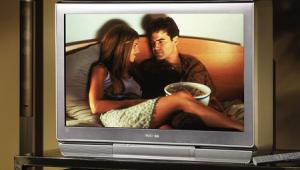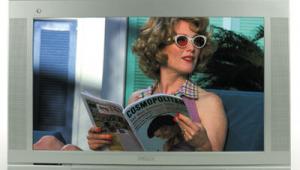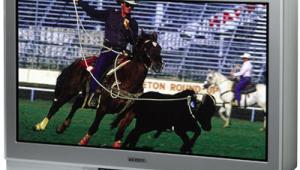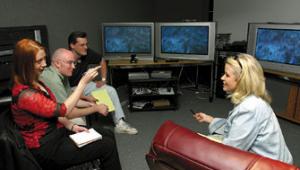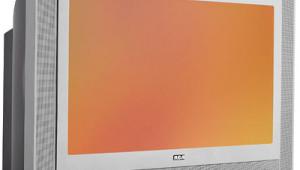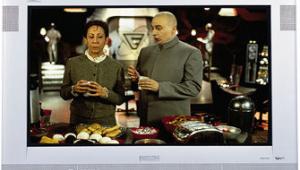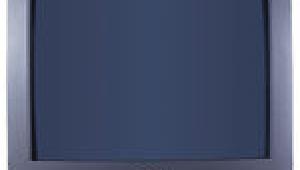Sony Wega KV-34XBR910 Direct-View HDTV
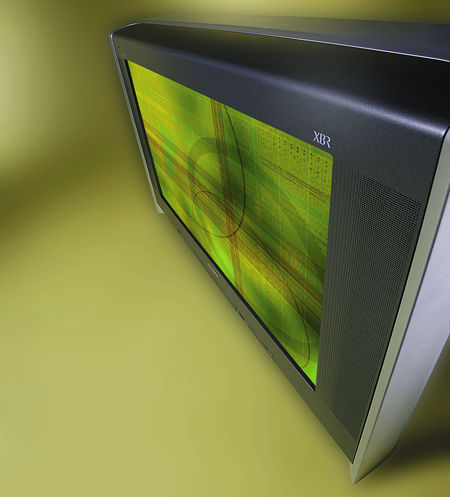
Now comes Sony's latest model in that lineage, the Wega KV-34XBR910, and it's a worthy heir. In fact, by some measures, it leaves that older but formidable product in the dust with several new features, particularly one that stands up well to the Sony publicity surrounding it: the so-called "super-fine pitch" picture tube and electron gun.
What that means in plain English is that the KV-34XBR910's aperture grille—which performs the same function as a shadow mask—is designed with 65% more slots than earlier models had. (The grille is a slotted sheet of metal between the glass faceplate and electron gun that allows the electron beam to pass through and hit the phosphors on target. The more slots in the grille, the higher the potential resolution.)
Outward Appearances, Inner Beauty
Like all models in Sony's Wega line, the KV-34XBR910's 16:9 screen is perfectly flat. It's housed in a handsome cabinet framed in black, with a protruding silver casing surrounding that. A few controls line the bottom, as well as a slot for Memory Sticks, Sony's memory cards that hold digital still and camcorder images; a button on the remote control calls up a menu to manage that. Sony seems to be sticking Memory Stick slots in every one of their products that can take it. The 34XBR910 Memory Stick slot supports jpeg images, mpeg movies and even MP3 Audio Files.
Like all high-end TVs, the KV-34XBR910 provides 3:2 pulldown correction, which Sony calls Cinemotion. It has a 3-D digital comb filter, which is of value to the rare bird who would buy an expensive TV like this—the price is $2499—and then use its composite-video (or RF) inputs. Sony boasts that the KV-34XBR910 includes adjustable scan-velocity modulation, which Sony calls ClearEdge. The good thing about ClearEdge is that you can adjust it all the way to Off, which was the first thing I did. Also included are one DVI/HDCP input and two component inputs. Only one of the latter can accept high-definition signals.
The KV-34XBR910 offers several aspect-ratio adjustments for watching 4:3 material on a 16:9 screen. The one that makes the most sense stretches the margins of the picture while keeping the center of the screen largely untouched; it worked quite well. These kinds of manipulations are important because of the size of 34-inch (diagonal) widescreen sets. If you watch a 4:3 broadcast-television or cable show at its proper aspect ratio, with gray panels on the left and right, the set provides you with nothing more than a 28-inch (diagonal) picture. That's pretty small.
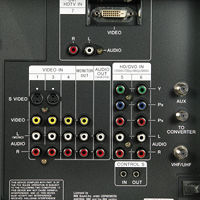 In fact, my issue with all of these 34-inch sets—which became ubiquitous throughout the industry after Sony built the first one five years ago—is that the picture is rather small for this era of big-screen TVs. Thomson made a 38-inch widescreen model that offered a somewhat larger picture, but that size never seemed to take off; Thomson now offers a 34-inch model, like everyone else. All the companies are trapped by the capabilities of the plants that make picture tubes, and all of them are tooled to produce 34-inch tubes.
In fact, my issue with all of these 34-inch sets—which became ubiquitous throughout the industry after Sony built the first one five years ago—is that the picture is rather small for this era of big-screen TVs. Thomson made a 38-inch widescreen model that offered a somewhat larger picture, but that size never seemed to take off; Thomson now offers a 34-inch model, like everyone else. All the companies are trapped by the capabilities of the plants that make picture tubes, and all of them are tooled to produce 34-inch tubes.
The KV-34XBR910 comes replete with many advanced features, including freeze-frame and picture-in-picture, which Sony calls Twin-View because their version lets you resize both windows however you like. The remote control is a variant of Sony's current standard model, with "TV" stamped on the bottom. (Other variants come with a label in the same place identifying the type of component they control and the functions of the buttons are altered to apply to the device at hand.) The remote is serviceable, and not as confusing as earlier Sony remotes. Although it's illuminated, it's not fully backlit.
The KV-34XBR910 displays all high-definition programming at 1080i unless its Digital Reality Creation (DRC) scaler is set to Progressive—in which case the display is 540p. Sony recommends using the Progressive setting only for still images and text, such as from a Memory Stick. In any case, 720p high-definition programming is converted to 1080i. In addition, DRC scales 480i signals to 960i.
Setup & Performance
Setup was easy, and the picture controls are complete. However, the KV-34XBR910 does not let you set up customized picture settings for each of its seven inputs. Instead, you can modify the settings for each of the set's four picture presets: Movie, Vivid, Pro, and Standard. It's not a perfect solution, but it's a serviceable compromise, given that many viewers will want to apply different picture settings for various program sources—cable, DVD, HD, etc.
From the moment I first slipped a DVD into the player, it was clear that Sony's claim of improved resolution for the KV-34XBR910 was real: The picture was incredibly sharp. To test this, I went immediately to the frequency-sweep pattern on the Video Essentials DVD (title 11, chapter 23). This is a row of vertical lines that grow closer and closer together as they move to the right until, at the right edge of the screen, the lines are barely visible and almost touch. With the exception of my reference projector, a Sony VPH-G90U with 9-inch CRTs, no TV I have reviewed has been able to fully resolve the entire pattern all the way to the bitter end. But the KV-34XBR910 duplicated the G90U's performance; the lines at the extreme right end were as clear as those at the left.
I wasn't the only one who was impressed. When Jamie Wilson, of Overture Audio/Video in Delaware, came by to calibrate the set, his first comment was, "The detail is amazing."
 Sony does not specify the KV-34XBR910's full resolution numbers; it does have 1080 horizontal lines, but the horizontal resolution is not stated. These days, most manufacturers of direct-view sets no longer bother to specify horizontal resolution. Still, in 1999 Sony acknowledged that their first direct-view HDTV provided 1080 lines by 900 pixels, which was less than half the horizontal resolution of the high-definition format: 1920x1080. I subsequently learned that nearly all direct-view sets have horizontal resolutions in that territory. I'd guess the KV-34XBR910's resolution is 1080 lines by something in the range of 1000–1200 pixels.
Sony does not specify the KV-34XBR910's full resolution numbers; it does have 1080 horizontal lines, but the horizontal resolution is not stated. These days, most manufacturers of direct-view sets no longer bother to specify horizontal resolution. Still, in 1999 Sony acknowledged that their first direct-view HDTV provided 1080 lines by 900 pixels, which was less than half the horizontal resolution of the high-definition format: 1920x1080. I subsequently learned that nearly all direct-view sets have horizontal resolutions in that territory. I'd guess the KV-34XBR910's resolution is 1080 lines by something in the range of 1000–1200 pixels.
I watched the Superbit version of Air Force One, a DVD I've used frequently as a reference. The Sony offered detail that I could not see on other sets I have reviewed recently; for example, the instrumentation in the plane's cockpit was more easily discernible than I can remember.
Colors were vivid but a bit out of whack—like virtually every TV I have ever reviewed, the KV-34XBR910 suffered from "red push." Even when all the other colors were perfectly adjusted, the reds were too vivid. I made the same observation in the May 1999 issue, when I reviewed this set's great-grandfather, the $8999 KW-34HD1 FD Trinitron. But even with the red push, the KV-34XBR910's color saturation was impressive; blacks were as dark as they could be—far more dark and rich than any plasma, DLP, or other new technology can offer.
The set's DRC scaler was quite good. Interlace artifacts were visible in particularly difficult scenes—flags waving, diagonal white lines on football fields, etc.—but almost completely absent at other times. On a continuum of 1 to 10, with an outboard Faroudja processor at the top, I give the Sony's scaler a score of eight. Sony has been continually refining the DRC algorithm for more than five years, and this iteration is the best yet.
I watched parts of several HBO movies in high-definition via DirecTV. I have not seen better HD from a commercial direct-view set. No, the KV-34XBR910 could not cross that threshold on the other side of which high-definition looks real, as if you were looking through a window. No direct-view CRT set can do that. But clarity and detail were outstanding, the color rendition was superb, and the entire viewing experience was exhilarating.
Conclusion
Sony's Wega KV-34XBR910 is among the most expensive 34-inch widescreen direct-view HDTVs; by comparison, Thomson's model costs $1699. But the Sony is the best-looking such TV I've seen, so I heartily recommend it.
